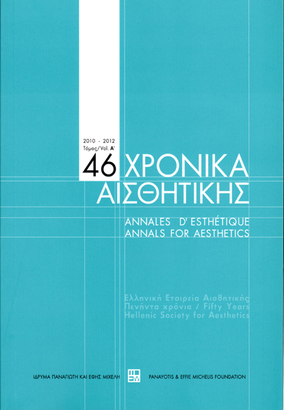Θέματα σύγχρονης αρχιτεκτονικής
Part of : Χρονικά αισθητικής : ετήσιον δελτίον της Ελληνικής Εταιρείας Αισθητικής ; Vol.44, 2007, pages 3-26
Issue:
Pages:
3-26
Parallel Title:
Issues of contemporary architecture
Section Title:
A' Μέρος/Part I
Author:
Abstract:
Architecture is no longer a scientifically determined autonomous region, but, rather, an expanding field that requires collaboration with other disciplines and sciences. Moreover, the method of conception and creation of architectural projects through digital means demands, apart from specialized knowledge, major changes in our way of thinking about this field. This expanded, complex, multifaceted field of architecture is being studied as an elective course in the domain of architectural morphology at NTUA, a domain which is based upon the valuable intellectual legacy that our professor P. Michelis has bestowed us.With this lecture, I attempt to go through the surface of this expanded field of architecture as well as to briefly describe the curriculum of the above mentioned elective. What should go beyond any individual architectural creation and ought to be our primary concern as architects is to provide solutions to the growing issue of housing, to the problem of land shortage and, of course, to be sensitive towards the energy crisis by attempting -first and foremost- to conserve the energy sources through our design.Those aforementioned issues have great impact to economic, social and political matters, and are deeply affecting our ideological and educational system. Those issues should determine and guide the true goal of architecture, both physically and conceptually, should direct the way our design adapts to existing morphological and social characteristics of the built environment. Architecture is inevitably connected with the past and the deeper its foundations are, the stronger is the conflict between past and present. Modernism is a good example: By substituting the then existing rules and values with their own theories and manifestoes, the Modernists transformed the morphological legacy of construction by employing new-modern materials and techniques. Shortly after, Postmodernism by supporting and encouraging subjectivity, rejected any aesthetic rule. Also, there is this type of architecture built in areas where tradition is still prevalent, supported by the theoretical background of critical regionalism, with various expressions yet a common goal to consciously embed architecture within a place and a society.In more contemporary paradigms, there are three leading ideas that seek to inspire architects:a. The landscape as integral part of urban planning with a new “picturesque” image as main ingredient. “Picturesque” is the aesthetical feature of traditional architecture. This fact can combine landscape issues with those of the integration of architecture in areas where tradition is still prevalent, supported by the theoretical background of critical regionalism, with various expressions yet a common goal to consciously embed architecture within a place and a society.b. Attempts to renew the “program” of architectural projects in order to join form and function through a network of information deriving from digital technology.c. The introduction of bioforms, using biological or crystal forms as inspiration.Projects as a result of such concepts benefit from the amazing advances of digital technology and representation.In each of the above expressions, architecture has inevitably been influenced by the forces and the aesthetics of a globalized culture of images and information. These elements become the topics to be explored in the teaching of Architectural Morfology, giving the chance to the students to form a critical thinking towards the recent architectural forms. With aesthetic criteria, apart from the historical, to be able to distinguish what is right from wrong, what are the reasons, the motivations, the results behind each architectural project.
Subject:
Subject (LC):
Keywords:
μοντέρνα αρχιτεκτονική
Notes:
Περιέχει εικόνες




